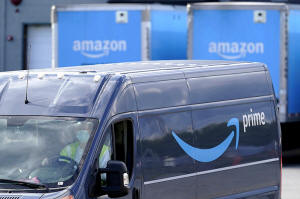Amazon expands its perishable delivery service, putting pressure on
traditional grocers
[August 14, 2025] By
ANNE D'INNOCENZIO
NEW YORK (AP) — Amazon is now rolling out a service where its Prime
members can order their blueberries and milk at the same time as basic
items like batteries and T-shirts and get them within hours.
The online juggernaut said Wednesday that customers in more than 1,000
cities and towns including Raleigh, North Carolina; Milwaukee; and
Columbus, Ohio, now have access to fresh groceries with its free
same-day delivery service on orders over $25 for Prime members, with
plans to reach over 2,300 cities and towns by year-end.
Amazon called the move “one of the most significant grocery expansions”
for the online retailer as it introduces thousands of perishable items
into its existing logistics network. The expansion is expected to put
pressure on grocery delivery services offered by such rivals as Walmart,
Kroger and Target, which all saw their shares take a hit in trading
Wednesday.
Amazon's shares rose 1%.
Amazon said that if an order doesn’t meet the minimum, members can still
choose same-day delivery for a $2.99 fee. For customers without a Prime
membership, the service is available with a $12.99 fee, regardless of
order size.
In the past, Prime subscribers’ grocery orders were fulfilled through
Amazon Fresh or Whole Foods Market.
Prime members pay $14.99 monthly or $139 annually.

Amazon launched its Prime membership in 2005, and it has become the gold
standard for subscription services with a slew of perks including
unlimited streaming with Prime Video and discounts at Whole Foods and
Amazon Fresh. Walmart, which launched its membership program called
Walmart + in 2020, has been racing to add more benefits. It costs $12.95
per month or $98 per year. Depending on members' location and
availability, Walmart members can schedule same-day delivery for their
groceries, including perishables.
“We’re continuously innovating to make grocery shopping simpler, faster,
and more affordable for our customers, especially Prime members,” said
Doug Herrington, CEO of Worldwide Amazon Stores, in a statement. “By
introducing fresh groceries into our Same-Day Delivery service, we’re
creating a quick and easy experience for customers. ”
Herrington noted that customers can order milk alongside electronics;
oranges, apples, and potatoes with a mystery novel; and frozen pizza at
the same time as tools for their next home improvement project—and check
out with one cart and have everything delivered to their doorstep within
hours.
[to top of second column] |

An Amazon Prime logo appears on the side of a delivery van as it
departs an Amazon Warehouse location in Dedham, Mass., Oct. 1, 2020.
(AP Photo/Steven Senne, File)
 The company first tested the service
in Phoenix, last year, and then added Orlando, Florida and Kansas
City, Missouri, earlier this year.
Amazon noted that many of its customers were first-time Amazon
grocery shoppers who now return to shop twice as often with the
same-day deliver service compared to those who didn't purchase food.
It also noted that based on early sales, strawberries now regularly
knock AirPods out of the top five best sellers of all products sold,
while bananas, Honeycrisp apples, limes, and avocados round out the
top ten best-selling perishable grocery items in their same-day
delivery carts.
“It's a nice step forward,” said Jason Goldberg, chief commerce
strategy officer at Publicis Groupe, a global marketing and
communications company. “It definitely makes them more competitive"
in perishables.
Goldberg noted that Amazon has struggled to succeed in fresh food
and that shoppers have been confused ordering shelf stable items and
perishables, and having them appear in different online shopping
carts, including Amazon Fresh. He said this move will greatly
improve the experience.
Amazon said it generated over $100 billion in gross sales of
groceries and household essentials last year not including sales
from Whole Foods Market and Amazon Fresh.
In June, Amazon said it was investing more than $4 billion to triple
the size of its delivery network by 2026, with a focus on small
towns and rural communities across the country.
It also noted that it's using artificial intelligence to help it
predict local customer preferences so it can stock popular items
alongside items targeted for specific communities
All contents © copyright 2025 Associated Press. All rights reserved
 |